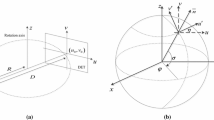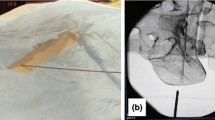Abstract
We explore three different alternatives for obtaining intrinsic and extrinsic parameters in conventional diagnostic X-ray frameworks: the direct linear transform (DLT), the Zhang method, and the Tsai approach. We analyze and describe the computational, operational, and mathematical background differences for these algorithms when they are applied to ordinary radiograph acquisition. For our study, we developed an initial 3D calibration frame with tin cross-shaped fiducials at specific locations. The three studied methods enable the derivation of projection matrices from 3D to 2D point correlations. We propose a set of metrics to compare the efficiency of each technique. One of these metrics consists of the calculation of the detector pixel density, which can be also included as part of the quality control sequence in general X-ray settings. The results show a clear superiority of the DLT approach, both in accuracy and operational suitability. We paid special attention to the Zhang calibration method. Although this technique has been extensively implemented in the field of computer vision, it has rarely been tested in depth in common radiograph production scenarios. Zhang’s approach can operate on much simpler and more affordable 2D calibration frames, which were also tested in our research. We experimentally confirm that even three or four plane-image correspondences achieve accurate focal lengths.












Similar content being viewed by others
References
Selby BP, Sakas G, Groch W-D, Stilla U. Patient positioning with X-ray detector self-calibration for image guided therapy. Aust Phys Eng Sci Med. 2011;34:391–400.
Markelj P, Likar B. Registration of 3D and 2D medical images. PhD Thesis, University of Ljubljana; 2010.
Miller T, Quintana E. Stereo X-ray system calibration for three-dimensional measurements. Springer, 2014. pp. 201–207.
Rougé A, Picard C, Ponchut C, Trousset Y. Geometrical calibration of X-ray imaging chains for three-dimensional reconstruction. Comput Med Imaging Graph. 1993; 295–300.
Trucco E, Verri A. Introductory techniques for 3-D computer vision. Prentice Hall Englewood Cliffs, 1998.
Moura DC, Barbosa JG, Reis AM, Tavares JMRS. A flexible approach for the calibration of biplanar radiography of the spine on conventional radiological systems. Comput Model Eng Sci. 2010; 115–137.
Schumann S, Thelen B, Ballestra S, Nolte L-P, Buchler P, Zheng G. X-ray image calibration and its application to clinical orthopedics. Med Eng Phys. 2014;36:968–74.
Selby B, Sakas G, Walter S, Stilla U. Geometry calibration for X-ray equipment in radiation treatment devices. 2007. pp. 968–974.
de Moura DC, Barbosa JMG, da Silva Tavares JMR, Reis A. Calibration of bi-planar radiography with minimal phantoms. In: Symposium on Informatics Engineering. 2008. pp. 1–10.
Medioni G, Kang SB. Emerging topics in computer vision. Prentice Hall. 2004.
Bushong S. Radiologic science for technologists: physics, biology, and protection. Elsevier. 2012.
Rowlands JA. The physics of computed radiography. Phys Med Biol. 2002;47:123–66.
Dobbins JT, Ergun DL, Rutz L, Hinshaw DA, Blume H, Clark DC. DQE(f) of four generations of computed radiography acquisition devices. Med Phys. 1995;22:1581–93.
Hartley R. Self-calibration from multiple views with a rotating camera. In: European Conference on Computer Vision. 1994. pp. 471–478.
Tsai R. A versatile camera calibration technique for high accuracy 3D machine vision metrology using off-the-shelf TV cameras and lenses. IEEE J Robot Autom. 1985;3(4):323–44.
Hartley R, Zisserman A. Multiple view geometry in computer vision. Cambridge University Press. 2004.
Zhang Z. A flexible new technique for camera calibration. IEEE Trans Pattern Anal Mach Intell. 2000;22:1330–4.
Remondino F, Fraser C. Digital camera calibration methods: considerations and comparisons. Symposium Image Eng Vis Metrol. 2006;36:266–72.
Zollner H, Sablatnig R. Comparison of methods for geometric camera calibration using planar calibration targets. In: Digital Imaging in Media and Education. 2004. pp. 237–244.
Gupta M, Upadhyay S, Nagawat AK. Camera calibration technique using Tsai’s algorithm. In: International Journal of Enterprise Computing and Business Systems. 2011.
Mckerrow PJ, Abrantes J. Problems encountered in the implementation of Tsai’s algorithm for camera calibration. In: Australasian Conference on Robotics and Automation. 2002. pp. 66–70.
Aziz AYI, Karara HM. DLT into object space coordinates in close-range photogrammetry. In: Symposium on Close-Range Photogrammetry. 1971. pp. 1–18.
Albiol AJ, Albiol A, Fernandez A, Rodrigo G, Albiol F. Dispositivo y procedimiento de obtención de imágenes densitométricas de objetos mediante combinación de sistemas radiológicos y cámaras de profundidad. Consejo Superior de Investigaciones Científicas. 2012.
Armangué X, Salvi J. Overall view regarding fundamental matrix estimation. Image Vis Comput. 2003;21:205–20.
Luong Q-T, Faugeras O. The fundamental matrix: theory, algorithms, and stability analysis. Int J Comput Vision. 1996;17:43–75.
Sánchez JA, Destefanis EA, Canali LR. Plane-based camera calibration without direct optimization algorithms. IV Jornadas Argentinas de Robótica. 2006.
Acknowledgments
This work was carried out with the support of Information Storage S.L., University of Valencia (Grant #CPI-15-170), CSD2007-00042 Consolider Ingenio CPAN (Grant #CPAN13-TR01), Spanish Ministry of Industry, Energy and Tourism (Grant #TSI-100101-2013-019), IFIC (Severo Ochoa Centre of Excellence #SEV-2014-0398), and Dr. Bellot’s medical clinic.
Author information
Authors and Affiliations
Corresponding author
Ethics declarations
Conflict of interest
We have nothing to declare for this study.
About this article
Cite this article
Albiol, F., Corbi, A. & Albiol, A. Evaluation of modern camera calibration techniques for conventional diagnostic X-ray imaging settings. Radiol Phys Technol 10, 68–81 (2017). https://doi.org/10.1007/s12194-016-0369-y
Received:
Revised:
Accepted:
Published:
Issue Date:
DOI: https://doi.org/10.1007/s12194-016-0369-y




